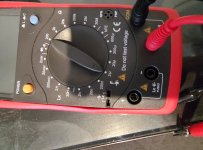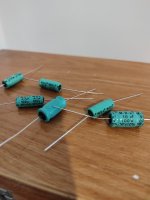I attempted to order the Mundorf 10's from Soundlabs.The two caps in the third order high pass filter would normally have different values would they not?
Just missed out.
They're now out of stock.
I'll grab them when they restock & will consider an international Mundorp order for the 4.7"s.
This way the cap positioning won't be an issue.
Quality across the board.
It's not unusual for the second one to be larger.
The Pageant 2 are 8 ohm nominal with crossover frequency 3,500 Hz.
Using these figures a third order high pass filter calculator gives approximately 8 uF followed by 11 uf on the tweeter so we're on the right lines.
This way the cap positioning won't be an issue.
I didn't consider which make of capacitor went where much of an issue as long as they were reasonably close to the required capacitance.
How are you getting on with locating the replacement miniature switches?
I was going to visit JayCar & Radio Parts armed with dimensions & photos when I get a chance.
Will also do some googling to see if I can source something suitable on line.
Will also do some googling to see if I can source something suitable on line.
The two independent toggle switches offer four choices of frequency response:
- Mid-frequency: level or -2dB, 1000-3,500 Hz.
- High frequency: level or -2dB, 3,500-25,000 Hz.
Quote: Galu: The two independent toggle switches offer four choices of frequency response:
Interestingly there are two cavities centrally located between the two toggles on the rear terminal plate.
Wiring terminates onto two terminals on the internal side of the cavities.
Red wire to upper terminal of the centrally located cavity.
Clear wire from central terminal of the left toggle switch to upper terminal of the centrally located cavity.
clear wire from circuit board to lower central terminal of the centrally located cavity.
It appears that you would insert a key which either shorts the circuit or engages the circuit??!!
Interestingly there are two cavities centrally located between the two toggles on the rear terminal plate.
Wiring terminates onto two terminals on the internal side of the cavities.
Red wire to upper terminal of the centrally located cavity.
Clear wire from central terminal of the left toggle switch to upper terminal of the centrally located cavity.
clear wire from circuit board to lower central terminal of the centrally located cavity.
It appears that you would insert a key which either shorts the circuit or engages the circuit??!!
I had a closer look at the miniature switches.How are you getting on with locating the replacement miniature switches?
It's an Arrow C TS3 made in england.
Don't know if its "on - on" or "on-off-on"??
Closest thing I've found is this.
https://www.tedss.com/2027002990
Looks like the U.S.A version.
Same external dimensions.
This version is "on-on".
This appears close but body is double width x length.
https://www.ebay.co.uk/itm/12218675...lp:4429486&itmmeta=01HQCWTSSS3GDBZ3BZJNBPBVTP
Last edited:
Interestingly there are two cavities centrally located between the two toggles on the rear terminal plate.
Those "two cavities" are the socket for the optional insertion of a DIN speaker plug instead of using the red and black bare wire speaker terminals.
Make a note/take photos of the wiring and wiring links to make sure you replace it all properly.
Above, a DIN speaker plug.
Last edited:
Don't know if its "on - on" or "on-off-on"??
I'd avoid the "Arrow Hart" as it initially says "on-none-on" which could be interpreted as "on-off-on".
An "on-on" is a simple changeover switch. The "Blue Switch" is clearly an "on-on" latching switch so it's OK.
The clue is the ON ON stamped on the switch body.
You do NOT want an "on-off-on" switch for the following reason:
On-off-on toggle switches are variations of the on-on design. They add a third, neutral off position in the centre.
In on-off-on switches, the off position is the default resting position and both on positions will click back to this once released.
I'd avoid the "Arrow Hart"
On second thoughts the "Arrow Hart" must be an ON - ON switch as stated in the DESCRIPTION, because the toggle in the photograph would be in the centre position if it were an "on-off-on" switch.
The "Blue Switch", because it is clearly stamped ON - ON on its body, leaves no room for doubt, and is less expensive.
Thanks for all the detailed information Galu.How are you getting on with locating the replacement miniature switches?
Very much appreciated.
Some good news.
I used 3 applications of CRC 2.26 squirted into the toggle switches.
Three are now free and I've switched these several times to help clean their contacts.
The fourth is still jammed but I'm sure I can free it up with more applications and some careful coaxing.
Saved money & time.
Also picked up the caps from Jaycar.
With 4.7µF buzzing around in my mind I selected these over the 5µF.
Will they do or should I wait and swap them when I visit Jaycar again?
Also its been awhile since I've used my meter.
Which setting do I use on the meter to measure µF's?
If the ones I'm keeping are out I can swap these as well.
Attachments
Fairly consistent, and reasonable. Keep in mind that meters aren't always outright accurate, but relative measurements usually fare better. Also, electrolytics may continue to form as they are used. Are you going to be using crocodile leads at the start?
Do you recommend using crocodile leads?
How would this be done, given the circuit board requiring de soldering & soldering, and the original caps would have had their terminals clipped?
How would this be done, given the circuit board requiring de soldering & soldering, and the original caps would have had their terminals clipped?
It's up to you how formal you choose to keep it, maybe this isn't important in your case.
I'm approaching this from a DIY perspective where access for continued testing and changing things around takes precedence over looks or portability. Crocodile leads can work well if you keep an eye on them from time to time.
I'm approaching this from a DIY perspective where access for continued testing and changing things around takes precedence over looks or portability. Crocodile leads can work well if you keep an eye on them from time to time.
It's a good technique to be aware of.
Don't know where my life will take me, but I do have thoughts of eventually building my own Loudspeakers sometime in the future.
Don't know where my life will take me, but I do have thoughts of eventually building my own Loudspeakers sometime in the future.
Also picked up the caps from Jaycar.
With 4.7µF buzzing around in my mind I selected these over the 5µF.
Will they do or should I wait and swap them when I visit Jaycar again?
You must be confused! Jaycar do not have 5 uF capacitors, just 4.7 uF ones.
Do you recommend using crocodile leads?
All you have to do is replace the old capacitors on the circuit board with the new ones.
I don't expect you to be undertaking "continued testing", just getting the speakers up and running for the owner.
Saved money & time.
But will your contact cleaning fix stand the test of time?
Personally, I would future-proof this restoration by fitting shiny new switches.
It would be ~£15 well spent in my book, but it's your choice.
The Arrow Hart switches would be 4 x US$12.99 plus a "Kings ransom" for international shipping. 😢Personally, I would future-proof this restoration by fitting shiny new switches.
It would be ~£15 well spent in my book, but it's your choice.
I'll have to source switches locally.
I thought flicking the switches a number of times will clean the contact surfaces.
Actuating them periodically will also keep them free.
They froze due to zero use over 40-50 years.
How about this?
https://www.jaycar.com.au/dpdt-mini...ance&searchText=miniature toggle switch on on
One problem, it's twice the width of current switch.
Also not clear if it's on on.
Last edited:
- Home
- Loudspeakers
- Multi-Way
- Assistance with Mordaunt Short Pageant Series 2

